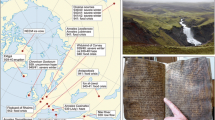Abstract
The eruption that started in the Hekla volcano in South Iceland on 17 January 1991, and came to an end on 11 March, produced mainly andesitic lava. This lava covers 23 km2 and has an estimated volume of 0.15 km3. This is the third eruption in only 20 years, whereas the average repose period since 1104 is 55 years. Earthquakes, as well as a strain pulse recorded by borehole strainmeters, occurred less than half an hour before the start of the eruption. The initial plinian phase was very short-lived, producing a total of only 0.02 km3 of tephra. The eruption cloud attained 11.5 km in height in only 10 min, but it became detached from the volcano a few hours later. Several fissures were active during the first day of the eruption, including a part of the summit fissure. By the second day, however, the activity was already essentially limited to that segment of the principal fissure where the main crater subsequently formed. The average effusion rate during the first two days of the eruption was about 800 m3 s−1. After this peak, the effusion rate declined rapidly to 10–20 m3 s−1, then more slowly to 1 m3 s−1, and remained at 1–12 m3 s−1 until the end of the eruption. Site observations near the main crater suggest that the intensity of the volcanic tremor varied directly with the force of the eruption. A notable rise in the fluorine concentration of riverwater in the vicinity of the eruptive fissures occurred on the 5th day of the eruption, but it levelled off on the 6th day and then remained essentially constant. The volume and initial silica content of the lava and tephra, the explosivity and effusion rate during the earliest stage of the eruption, as well as the magnitude attained by the associated earthquakes, support earlier suggestions that these parameters are positively related to the length of the preceeding repose period. The chemical difference between the eruptive material of Hekla itself and the lavas erupted in its vicinity can be explained in terms of a density-stratified magma reservoir located at the bottom of the crust. We propose that the shape of this reservoir, its location at the west margin of a propagating rift, and its association with a crustal weakness, all contribute to the high eruption frequency of Hekla.
Similar content being viewed by others
References
Einarsson T (1949) The eruption of Hekla 1947–1948: IV, 3. The flowing lava. Studies of its main physical and chemical properties. Soc Scientiarum Islandica, Reykjavik, 1–70
Einarsson P, Bjornsson S, Foulger G, Stefansson R, Skaftadottir Th (1981) Seismicity pattern in the South Iceland seismic zone. In: Simpson D, Richards P (eds) Earthquake prediction — an international review. Am Geophys Union, Washington, pp 141–151
Global Volcanism Network Bulletin (1990) Smithsonian Institution. Washington DC 15: 12:2
Gronvold K, Larsen G, Einarsson P, Thorarinsson S, Saemundsson K (1983) The Hekla eruption 1980–1981. Bull Volcanol 46:349–363
Gudmundsson A (1987) Lateral magma flow, caldera collapse, and a mechanism of large eruptions in Iceland. J Volcanol Geotherm Res 34:65–78
Gudmundsson A (1988) Effect of tensile stress concentration around magma chambers on intrusion and extrusion frequencies. J Volcanol Geotherm Res 35:179–194
Jakobsson SP (1979) Petrology of Recent basalts from the eastern volcanic zone, Iceland. Acta Naturalia Islandica 26:1–103
Johannesson H, Einarsson S (1990) Glefsur ur sogu hrauna og jardvegs sunnan Heklu. In: Arnalds A (ed) Graedum Island. Landgraedslan, Reykjavik, pp 123–136
Johannesson H, Jakobsson SP, Saemundsson K (1990) Geological map of Iceland, sheet 6, South Iceland, third edition. Icelandic Museum of Natural History and Iceland Geodetic Survey, Reykjavik
Kjartansson G (1957) The eruption of Hekla 1947–1948: III, 1. Some secondary effects of the Hekla eruption. Soc Scientiarum Islandica, Reykjavik, 1–42
Kjartansson E, Gronvold K (1983) Location of a magma reservoir beneath Hekla volcano, Iceland. Nature 301:139–141
Larsen G, Thorarinsson S (1978) H4 and other acid Hekla tephra layers. Jokull 27:28–46
Oskarsson N (1980) The interaction between volcanic gases and tephra: fluorine adhering to tephra of the 1970 Hekla eruption. J Volcanol Geotherm Res 8:251–266
Rowland SK, Walker GPL (1987) Toothpaste lava: characteristics and origin of a lava structural type transitional between pahoehoe and aa. Bull Volcanol 49:631–641
Sigmarsson O, Hemond C, Condomines M, Fourcade S, Oskarsson N (1991) Origin of silicic magma in Iceland revealed by Th isotopes. Geology 19:621–624
Sigvaldason GE (1974) The eruption of Hekla 1947–1948: V, 1. The petrology of Hekla and origin of silicic rocks in Iceland. Soc Scientiarum Islandica, Reykjavik, 1–44
Stefansson R, Sacks IS, Linde AT (1980) The Hekla eruption of 1980-the mechanism of a ridge volcano. Carnegie Inst Yb 80:511–514
Thorarinsson S (1967) The eruption of Hekla 1947–1948: I. the eruptions of Hekla in historical times. A tephrochronological study. Soc Scientiarum Islandica, Reykjavik, 1–170
Thorarinsson S, Sigvaldason GE (1972) The Hekla eruption of 1970. Bull Volcanol 36:1–20
Author information
Authors and Affiliations
Rights and permissions
About this article
Cite this article
Gudmundsson, A., Oskarsson, N., Gronvold, K. et al. The 1991 eruption of Hekla, Iceland. Bull Volcanol 54, 238–246 (1992). https://doi.org/10.1007/BF00278391
Received:
Accepted:
Issue Date:
DOI: https://doi.org/10.1007/BF00278391




